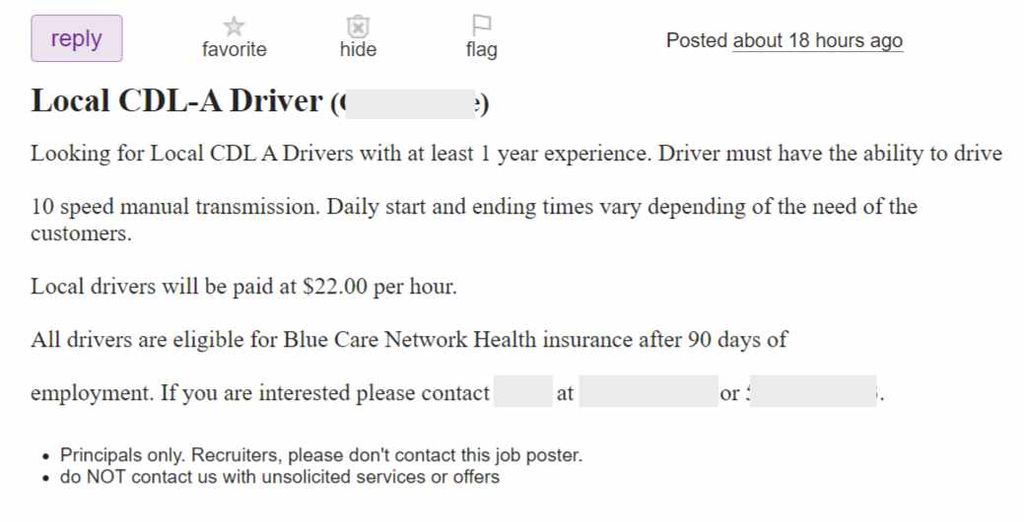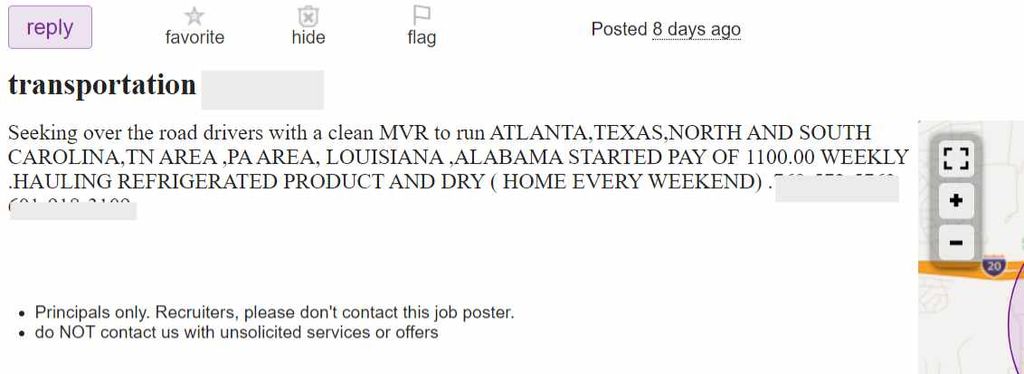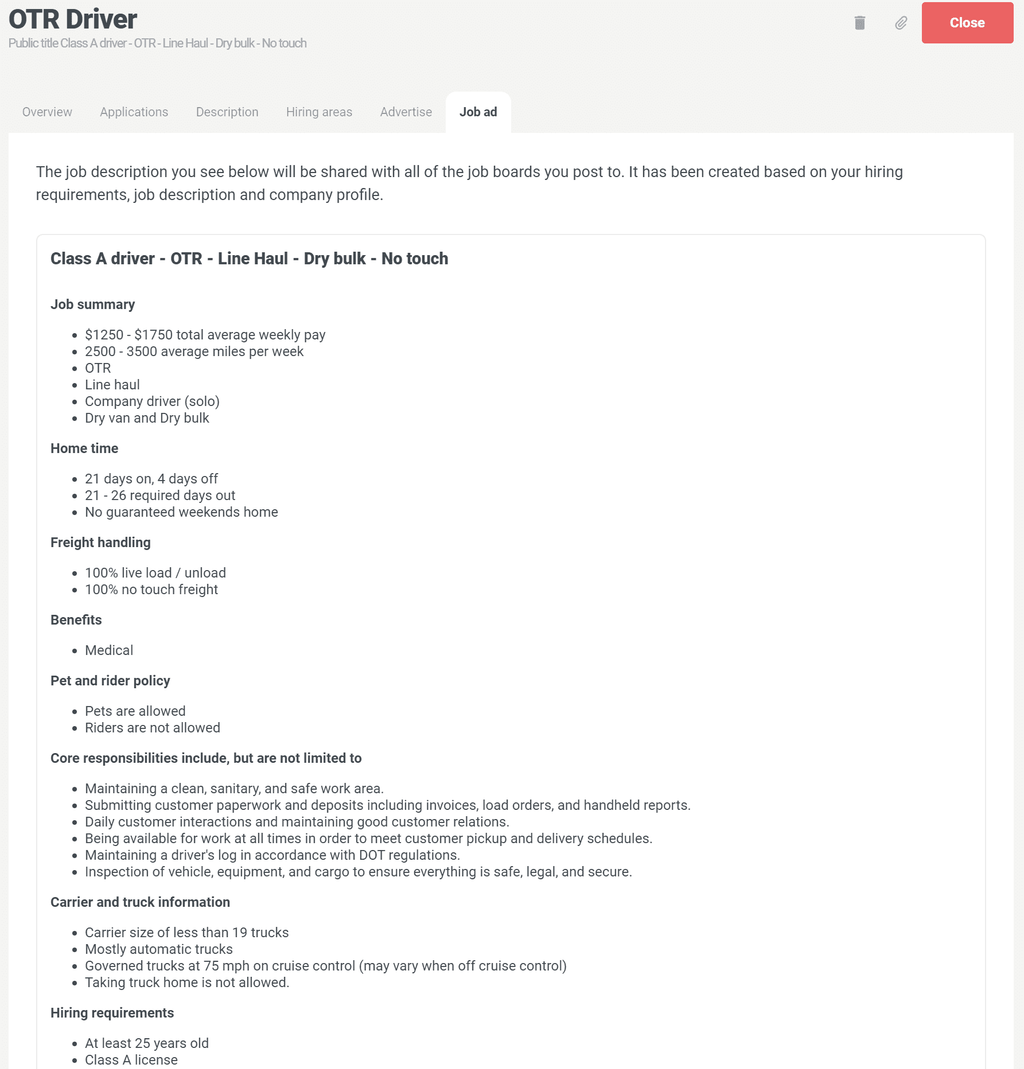Advertising is an essential part of every trucking company’s recruitment strategy. In order for your job ads to perform to the top of their potential, it’s essential that you employ a multi-faceted approach - and present your job to your candidates the right way.
How your job ad looks, where it’s placed, and the way in which it is presented all contribute to your recruitment success.
In this post, we’ll go over why job ads are important, compare successful and unsuccessful job ads (and find out what really makes the difference), explore the importance of where your ads go, and more.
Disclaimer: This post is for serious and diligent driver recruiters only. This information will be valuable to you if you are already making serious efforts to improve your recruitment processes.
Why your job ad is important
Unless you’re a mega carrier, it’s safe to assume that a driver seeing your ad online has never heard of your company. This puts a lot of weight on your job advertisement, to not only provide a solid overview of your job offering, but to function as a great first impression of your company.
Your job ad says a lot about your company:
- The clarity of your communication.
- Your transparency about the position.
- The extent to which you make big claims and promises.
- What information you choose to highlight (sign on bonus over operating area) shows how connected you are with driver needs & their experience.
Your ad functions as a powerful opportunity to create a lasting impression, and attract the right drivers. Not only does it determine whether a driver remembers or forgets about your company, it directly impacts the quality of your leads and your chance at making a hire.
Imagine you’re on an advertising “fishing” boat. You’re catching drivers with your ads. A bad ad is like a fishing net that catches everything - shoes, seaweed, old jeans… no good.

How often do you deal with leads like this?
A good ad, on the other hand, can be seen as a magical fishing net that catches quality drivers and helps filter out the ones that waste your time. This metaphor is getting a little messy, so I’ll move on...
The bottom line: The quality of your job ad directly translates to how many leads you get, and how relevant those leads are to you!
Let’s take a look at a successful job ad (meaning an ad that ticks all the right boxes), and contrast it against what I would consider an unsuccessful job ad.
What makes a job ad great?
We currently run Facebook campaigns for dozens of carriers across the country. This gives us a rare opportunity to see what drivers are saying and thinking about jobs as they’re applying.
What we’ve confirmed is that drivers are a skeptical and jaded bunch (as if there was any doubt). Successful carriers always keep that in mind when advertising to them. They know that drivers aren't easily fooled by lofty promises and big numbers. And even if such an underhanded tactic works, it'll never bring long term success. The better bet is concise, relevant, detailed information delivered in a readable and attractive format.
We asked JT Peters, industry veteran and CEO at Truck Driver Power, for his insights into what makes a good job ad. He replied with this:
"CDL drivers are inundated with job communications and the copy is rarely relevant. Messaging needs to be personalized and targeted. Broad and general advertisements waste time and money."
He continues...
"Leveraging a highly targeted platform (...) with personalized content for discretely segmented driver audiences, such as Solo Northeast Regional Flatbed Company Drivers, triggers relevant drivers' attention and elicits a positive response"
What JT is saying is that specificity wins over a general "wide net" approach any day. Essentially, the less targeted and relevant your ad is, the less likely it is to attract the drivers you need. He also stresses the importance of relevant titles with appropriate keywords that are readable at a glance.
I agree that the essentials of a job ad come down to how specific it is and how much information it provides to drivers at a glance. It is also true that drivers are overwhelmed by job offers and job ads, and that they are unlikely to read long, solid chunks of text.
The recipe for a good job ad:
- A tight and relevant job title - A good job ad has a descriptive title that sums up the most important elements of the job: The route type, the type of trailer, whether or not the job is dedicated, and so on. It does not feature dollar sign emojis... 💸💰💵
- Realistic pay averages - If detecting BS was a job, truck drivers would be excellent at it. Companies with good ads understand that they can’t get away with lying to their potential hires by listing an unattainable figure as their weekly pay. Instead, they provide a realistic pay range.
- Type of employment - Is your job 1099 or W2? Solo or team? A good ad makes that information clear and unambiguous.
- Trailer types & details - What trailers a driver is expected to haul. Bonus points for detailed information about load types.
- Freight handling - How much of the freight is driver touch / how much is live load and unload, et cetera.
- A clear operating area - Specifying your operating area is especially important for regional and local jobs. This is something many companies overlook. Some companies don't list their operating areas out of fear, because a Northeast route isn't as attractive as a Southeast, for instance. A good ad is honest and transparent, and is better off for it.
- Extra details and policies - For example, if you're running a flatbed position, a good ad would specify how much tarping would be required of the driver. It's always good to include your pet and rider policies, too. Oh and, don't forget to include your benefits.
Let's take a look at an example of a job ad that I think ✔ ticks all the right boxes. I found this example on the Lanefinder website.

**Note how: **
- The information is presented in a readable way.
- The company is introduced briefly and succinctly.
- The operating area of the job is also displayed visually above the ad, which gives drivers a solid indication of where they will be driving.
- The pay range provided is reasonable, and no space is taken up on extravagant claims.
Overall: The job ad above provides enough information to attract relevant driver leads that are likely to be qualified and interested in the job. It does not leave room for confusion, and is unlikely to attract drivers that are a poor match. In turn, it wastes less of the recruiter's time.
Now let's look at a few job ads that could use some improvement.
What makes a job ad not so great?
I won't go too deep into this, because I'm sure it's pretty obvious without me having to say anything. In short: Take everything that I mentioned above and flip it on its head.
A bad ad is broad, general, vague, meandering, attention grabbing (in all the wrong ways) and occasionally dishonest.
Let's take a look at a few examples.
Example #1

This ad is very short and fails to answer a lot of questions a driver may have:
- Is this job full time or part time?
- Is this W2 or 1099?
- What's my expected weekly average pay?
- How many hours am I expected to work per week?
- What kind of trailer is it?
- Will I be touching freight?
There's room for improvement. That's not a condemnation of the ad, and the company that posted the ad doesn't have bad intentions. In fact, like many smaller carriers, they are likely overworked and oftentimes far too busy to pay much attention to how they advertise their jobs. Though this job ad isn't very descriptive or specific, at least it isn't bombastic or dishonest.
The big problem is that the ad is too general. A job ad like this is not doing any favors for a company of overworked people. What an ad like this will lead to is a bunch of conversations that go nowhere with candidates that are unlikely to convert into hires. Why waste the time?
Example #2

Pros:
- Operating area is included
- Starting pay is included
- Home time is included
- Type of trailer is included
Cons:
- Amount of experience required not stated
- Length of trailer nowhere to be seen
- Type of contract not presented
- Not readable at a glance
- No company name
- Too general - how can they expect to hire quickly with an ad like this?
I want to make it very clear that I am not pointing out these examples to make fun of these companies. Likely, this ad is another example of a small operation trying to handle a massive workload. By the looks of it, this company is probably relatively small, likely consisting of just a few trucks. Hell, the owner may be doing most of the work him / herself at this point.
But the bottom line for this company is that this ad, just like the previous one, is not doing them any favors! Putting an ad like this on a saturated platform filled with thousands of other jobs is just asking to be ignored. It's an ad that doesn't fulfill its purpose, and is unlikely to attract any attention.
If the driver is left with more questions than answers after viewing your ad, it's likely your ad needs improvement. If your ad provides more answers than questions, it's probably on the right track!
Having taken the time to understand what makes an ad decent and an ad not so decent, let's look at another vital component of an effective advertisement.
It's not just how you post, it's where you post
Where you post and how you get a driver's attention is just as important as your job ad. The fact of the matter is that even a great ad on a saturated platform may be doomed to remain unseen. On saturated advertising platforms, job advertising becomes a vicious fight for attention as hundreds of carriers all enter into the equivalent of a shouting match. That's not cool!
We've written a few blog posts on this topic in the past, so instead of going super in-depth, let's just take a look at some of the main points we've covered:
- Facebook ads: Facebook ads can be a valuable ally when you’re hiring drivers. They allow you to reach the target audience you need and, when pulled off effectively, get hires at a consistently low cost. Facebook ads also provide a rare opportunity to reach passive candidates where they spend most of their downtime. In other words: get the attention of drivers that aren’t actively browsing through jobs on job boards. This is a big deal.
- Lanefinder: Lanefinder's website and mobile app allows drivers to easily filter through and find jobs that match their preferences in their area. The standardized and automated process through which jobs are created (via YouCruit) means that all job ads look aesthetic and presentable out of the box. No effort required on the carriers' part.
- Upgrading your online presence: Sometimes it's wise to take a big picture approach to understand why your company isn't getting the application it deserves. This post is full of tips that can help you upgrade your digital presence to attract more driver applications.
- Some jobs just need a boost!: Sometimes, putting a little bit of gas in the tank is all it takes for your application numbers to skyrocket! Many smaller carriers are afraid to put money into their recruitment, fearing that it'll go to waste. But paying for ads can actually be quite simple once you discover the neat calculation featured in this post.
Digitization and automating your job ad descriptions
Streamlining and digitizing your recruitment process is Step One to improving your life as a driver recruiter. In this day and age, all trucking companies, small and large alike, need good software. Trucking specific recruitment software that helps sort out every step of the recruitment process.

This is an example of auto-generated ad text created when a job is set up in YouCruit. No effort at all.
Driver recruiting software does so much more than just sort out how your ads look, but it can do that too. Our driver recruiting software, for instance, does just that. It takes thorough (and easy to set up) job forms and converts them into readable and attractive ads. Now, nobody likes being advertised to, but before you plug your ears and go la la la, I want to reassure you that my intentions are pure.
This is not about selling you on the idea of buying or using a certain product or service to fix your issues. You can continue doing everything manually, if you prefer. However, digitization is the way forward, and now is the time when previously prohibitive tech is finally being made available to the vast majority of the trucking industry. Any company that wants to stay competitive and efficient simply cannot miss out on the benefits that an industry specific applicant tracking system can provide.
Bottom line: When it comes to the benefits of digitization, job ads are just the tip of the iceberg.
Conclusion
Your job ad is just a (relatively small) part of your recruitment arsenal. Still, it can make a big difference in how much time you waste and the quality of leads you receive. As a component of your overall recruitment package, job ads play an important role in keeping you efficient and competitive.
Before you put your efforts into making a great job ad, however, you need to make sure you have the basics covered. After all, making a great ad for a not so great job would really be putting the cart before the horse. To have stand a chance in the highly competitive marketplace, you need to make sure what your pay proposition is high enough.
Here are a few tips to help you sort that out:
- Use the NTI (National Trucking Institute) to get an idea of your competitors' wages.
- Find out how much the average driver gets paid according to data from our friends at Lanefinder. They'll keep us updated as the quality and quantity of their stats increases!
Thanks for your time, and if you have any specific questions or would like to have a conversation with us, shoot an email to sales@youcruit.com any time and we'll get back to you!